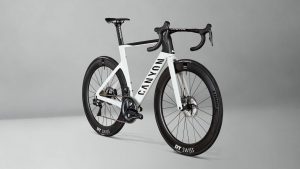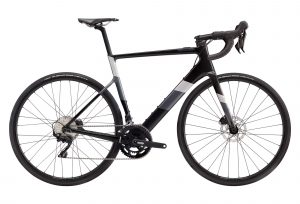Fitness activities such as cycling are more powerful and enjoyable when done as a team. Considering their features and benefits, which between Canyon and Cannondale bikes would be the better bike?
Hi, I’m Patricia and I’ve been racing regionally and globally for a decade now. I come from a family of pro-cyclists and it was just natural for me to follow in the family business.
There are a lot of things I love about my line of work but I have to say the best is getting free samples of new innovative machines to test ride and make reviews out of my riding experience.
So, here are two awesome aerodynamic bikes that I know you are going to love! Let’s get into it.
What is the difference between Canyon and Cannondale?
Mode |
Canyon Aeroad |
Cannondale |
Frame |
Canyon Aerod CFR |
BallisTec Carbon |
Groupset |
Shimano Dura-Ace Di2 |
Shimano Ultegra hydro disc |
Wheels |
DT Swiss ARC |
Fulcrum Racing 600DB |
Tires |
Continental GP |
Vittoria Rubino Pro Bright |
Brakes |
Shimano Dura-Ace Ice tech Freeza |
Shimano Ultegra hydro disc |
Saddle |
Selle Italia SLR |
Fabric Scoop Shallow Sport |
Availability |
Canyon vs Cannondale: How they compare
Frame
Canyon’s frame is low and long creating an aggressive poise while Cannondale takes on a vertically compliant frame best for high speeds and aerodynamics.
Canyon’s frame design integrates all the cables internally and the handlebar can be adjusted up and down between 5mm to 15mm.
This frame is built to work in tandem with the handlebars which are 40mm in size overall and it provides for 20mm adjustments on each side.
The adjustable thing here is having a handlebar set at varying lengths to match with the bike sizes. Because the cockpit is fully integrated, that serves the racer better and accommodates for longer races.
The Cannondale bikes are made of BallisTec carbon which is both lightweight and strong enough to attain high speeds and aerodynamic effects.
You get the SAVE PLUS technology which provides comfort using the vertical compliance created without resulting in extreme stiffness that hinders efficiency and speed.
Cannondale measures a head angle of 66-degrees and features 51mm and 44mm offset hooks that work with the 29-inch and 27.5-inch wheel respectively. It has a trail measuring 112mm long with a 435mm chainstay and 430mm for the arm-reach.
Components
The Canyon provides a D-shaped Seatpost surrounded by a hollow carbon shroudfor wider and better comfort than the Cannondale which has a Fabric Scoop saddle that is just long.
For better flex of the Seatpost, the clamp is located at the back of a seat tube. An Allen key is all you need to make the necessary adjustments.
The Selle Italia SLR saddle is the bare minimum for me because the padding is almost not there and I can’t bear the discomfort even if it was ironically.
However, my experience is subjective so you would have to make your assessments and conclude.
Cannondale is fitted with the Vittoria Rubino Pro tires that are 30mm in width and are of low pressure. Unlike Defy, they are not tubeless so riding with a caution against potholes is prudent to do.
You may need to move the saddle more to the rear and lower in order to position it just above the pedals.
Because the bikes are based on the BB30 bottom bracket, they use the 50/34 tooth crankset and an 11-34t cassette.
Riding Experience
The descents on Canyon are unexpectedly stable and quiet which is preferred over Cannondale’s super responsiveness around corners.
For such a lightweight bike, riding Canyon feels very fast with no harshness or shaky experiences.The bikes display only the best performance in cornering with impressive grip and speed gain on the road.
The Cannondale bike is designed to be an all-time comfortable peddling option and uses the Ultegra components at the front and rear ends.
When going downhill, the bike is stable and rides quite well. Realigning your bike by 5-degrees requires you to use the flip-chip which will effectively realign the angle of your head and set tubes.
It is capable of riding over cobbles and rough roads giving a very quiet and smooth riding experience.
Canyon vs Cannondale: A Comparison Overview
Canyon Review
The company transformed into a bike manufacturing business in 2001 and was called Canyon Bicycles.
The company employs a direct sales method through online platforms and while this cuts down on customer’s investment in time and energy, it also limits those who like to test drive before they buy a machine.
Canyon Ultimate
Incorporates a stiff frame and low weight to speed up. Features a geometry that is meant to be comfortable for regular cyclists who are not as resilient.
Available either with disc or without and features integrated stems and deeper wheels for aero bikes. they provide female-tuned versions as well.
Canyon Endurance
An all-day bike made into Sport Geometry putting you on an upright position to prevent pressure on arms or lower back.
Made of carbon, this bike incorporated the vertical compliance, lateral stiffness VCLS which splits the Seatpost to cushion the rider from road vibrations.
Can be ridden all year round because the disc brakes can control wheels even when it’s slippery and wet.
Pros
- Stiff and fast
- Lightweight
- Comfortable rear
- Includes power meter
- Handlebar width adjustable
Cons
- Front suffers on rugged roads
- traditional saddle
Cannondale Review
They have the reputation of being the creme-de-la-creme of all road bikes because of their sleek and elegant designs. Whether male or female, they have everything for everyone, and after just one ride, it will be impossible to consider other options.
Cannondale Synapse
This is a stiff, light and fast bike that is comfortable for most which is good for long rides. it is made of BallisTec carbon and uses SRAM force AXS shifting.
The lightweight build and geometry are designed to enhance your riding potential by being super responsive and powerfully accurate in quick turns.
Cannondale Topstone
A gravel bike with suspension that is excellent for both on- and off-road experiences. It is made of carbon material and features Kingpin suspension.
Handling and control is managed by SRAM Force eTap AXS 12-speed and a HollowGram SAVE handlebar running on a Carbon wheelset.
Pros
- Lightweight and strong carbon build
- Big range of and quick shifting between speeds
- Prioritizes comfort and excellent performance for long races
Cons
- Limited to average-sized cyclists
Conclusion
Canyon bikes are not designed for climbs but they can excel at shallower and longer climbs when compared to the other models.
Cannondale bikes on the other hand are loved for their quality design that incorporates safety, durability, and the capacity to conquer sharp turns or downhill racing.
Verdict: So, which is better – Canyon or Cannondale?
The Canyon bikes have a leg over the Cannondale.This is because they offer riders an aggressive yet comfortable riding position that lets you go as fast you can envision. What’s more, it allows for adjustments that are fuss-free.
FAQ
What is Countervail technology?
This is a process whereby viscoelastic resin is blended with a carbon frame to create a dampening effect to quell vibration and boost strength.
How will I know to make the right adjustments to my bike?
Your bike of choice will come fully assembled and adjusted but to help you out, there is always a menu that explains the different parts and how to care for your bike.


